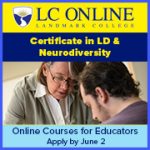 A well-trained teacher or tutor in an adult literacy program should be trained in at least three methods, including the multisensory approach, which has proven to be effective for adult students with learning disabilities. A multisensory method uses a combination of visual, auditory and tactile-kinesthetic instruction to enhance memory and learning. Following is a list of multi sensory structured language programs. This list does not include every available adult literacy reading program; however, many of the programs listed are based on the “Orton Gillingham-Stillman Approach.” This approach is often described as the grandfather of many successful multisensory
A well-trained teacher or tutor in an adult literacy program should be trained in at least three methods, including the multisensory approach, which has proven to be effective for adult students with learning disabilities. A multisensory method uses a combination of visual, auditory and tactile-kinesthetic instruction to enhance memory and learning. Following is a list of multi sensory structured language programs. This list does not include every available adult literacy reading program; however, many of the programs listed are based on the “Orton Gillingham-Stillman Approach.” This approach is often described as the grandfather of many successful multisensory
reading programs.
Proven Methods:
Alphabetic Phonics
Alphabetic Phonics was developed by Lucius Waites, M.C. and Aylett R. Cox. Alphabetic Phonics is based on Orton-Gillingham techniques and emphasizes intense phonetic analysis of written language. The program is presented in a structured, multisensory sequence of alphabet, reading and spelling. Contact: Texas Scottish Rite Hospital, 222 Welborn Street, Dallas, TX 75219: 214.559.7815, www.tsrhc.org/dyslexia.
Barton Reading and Spelling System
Barton Reading and Spelling System was developed by Susan Barton. The Barton System is an Orton-Gillingham based program designed for volunteer tutors in adult literacy programs. Training is provided on videotape with fully scripted lesson plans. Contact: Barton Reading and Spelling System, 2059 Camden Ave., Suite 186, San Jose, CA 95124, 408.559.3652, www.bartonreading.com.
Multi-sensory Teaching Approach
Multisensory Teaching Approach (MTA) was developed by Margaret Taylor Smith. MTA is a comprehensive, multi-sensory program in reading, spelling, cursive handwriting, and alphabet and dictionary skills. Based on Orton-Gillingham techniques and Alphabetic Phonics. Contact: MTS Publications at www.mtspublications.com or 877.552.1090.
The Herman Method
The Herman Method was developed by Renee Herman. Teaches decoding, sight words, structural analysis, contextual clues and dictionary skills with consistent emphasis on comprehension. A remedial reading program that can be taught by trained paraprofessionals. A phonetic, structured, sequential approach based on the Orton-Gillingham Method and specifically designed for students with dyslexia/specific reading disability. Contact: Romar Publications, 4700 Tyrone Ave, Sherman Oaks, CA 94123: 818.784.9566.
Landmark Methodology
Landmark Methodology is a structured multi-sensory reading, spelling and writing program. Contact: Landmark Outreach Program, P.O. Box 227, Prides Crossing, MA 01965, 968.236.3216, www.landmarkoutreach.org.
Lindamood-Bell
Lindamood-Bell was developed by Patricia Lindamood and Nancy Bell. Lindamood-Bell program offers intensive treatment to develop reading, spelling, language comprehension, visual motor processing, and the ability to follow oral directions. Contact: Lindamood-Bell Learning Processes, 416 Higuera, San Luis Obispo, CA 9430: 800.233.1819 / 805.541.3836, www.lindamoodbell.com/programs.
Orton-Gillingham Method
Orton-Gillingham Method was developed by Dr. Samuel Orton and Anna Gillingham. Orton-Gillingham Method was developed and published in 1935. A multi-sensory, structured reading and writing program. Contact: Academy of Orton Gillingham, P.O. Box 234, Amenia, NY 12501: 914.373.8919, www.ortonacademy.org.
Project Read
Project READ was developed by Dr. Mary Lee Enfield and Victoria Green. Project READ is a method of teaching that is systematic, multi-sensory, concrete and involves direct instruction. It is a language arts program based on the theories of Samuel Orton. Contact: Project READ, P.O. Box 20631, Bloomington, MN 55420: 800.450.0343, www.projectread.com/.
Slingerland Approach
>Slingerland Approach was developed by Beth Slingerland. The Slingerland Approach is based on Orton-Gillingham techniques. All learning takes place through the involvement of the auditory, visual and kinesthetic motor channels. It is the linkage of these channels that individuals with dyslexia often find challenging. The Slingerland Approach starts with the smallest unit of sight, sound and feeling: a single letter. Expanding upon that single unit, students are taught through an approach which strengthens inner-sensory association and enables the strong channel of learning to reinforce the weak. It is thorough and integrated, providing a complete language learning experience. Contact: Slingerland Institute for Literacy, 12729 Northup Way, Suite 1, Bellevue, WA 98005: 425.453.1190, www.slingerland.org.
Wilson Reading System
Wilson Reading System was developed by Barbara Wilson. The Wilson Reading System is a 12-step remedial reading and writing program for individuals with language-based learning disabilities. The system specifically teaches strategies for decoding and spelling. It also includes oral expressive language development and comprehension. Visualization techniques are used for comprehension. Based on the Orton-Gillingham teaching techniques. Contact: Wilson Language Training, 162 West St, Millbury, MA 01527-1943: 800.899. 8454, www.wilsonlanguage.com.
Dyslexia Training Program
Dyslexia Training Program was developed by the Texas Scottish Rite Hospital Laboratory. The Dyslexia Training Program (DTP) + Rite Flight: A Classroom Reading Rate Program (RF Rate) and Rite Flight: A Classroom Comprehension Program (RF Comprehension) is a two-year dyslexia intervention that meets the National Reading Panel recommendations as a comprehensive Tier III reading intervention program. This video-based series provides expertise and classroom instruction delivered by a trained professional while an onsite facilitator provides attention to individual needs. he multisensory lessons target six instructional components which include both explicit and systematic instruction in phonemic awareness, phonics, fluency, vocabulary, comprehension, and spelling. For more information, go to community.tsrhc.org/educational-outreach-dtp.
Note from editor: There are multitudes of materials available online regarding teaching with multisensory instruction, far too many to list here. For more ideas, search for multisensory instructional materials and/or videos on your web browser.


